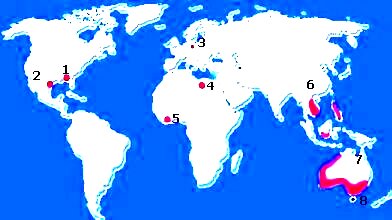

|
| Tektites are chunks of glassy material found in a number of locations across the globe. Most are blackish in colour and show signs of exposure to intense heat. The exceptions to this are the beautiful (and rare!) Moldavites from Eastern Europe, the yellowish Libyan glassites and the green-grey Darwinites. Moldavites are often an exquisite emerald green colour, and are frequently used in jewellery making. |
 |
|
1)
Georgia tektites |
5)
Ivory Coast tektites 6) Indo-chinese tektites 7) Australian tektites 8) Darwin tektites |
| There
has been much controversy about the origins of tektites: their appearance
and distribution in 'strewn fields' suggests a meteoric origin, but their
chemical composition is very close to that of terrestrial rock types. Many geologists believe that most tektites were created when massive impacts hurled molten surface rocks high into the atmosphere: remelting on re-entry produced the characteristic shapes and evidence of ablative heating. Other types may have been formed in situ by the extreme energies of a meteoric impact. However, recent research by former NASA astronomer Dr. John A. O'Keefe suggests that Tektites may have had their origin in lunar volcanoes or impacts, and that they may once have orbited the Earth as a Saturn-like ring! Read about it HERE! |